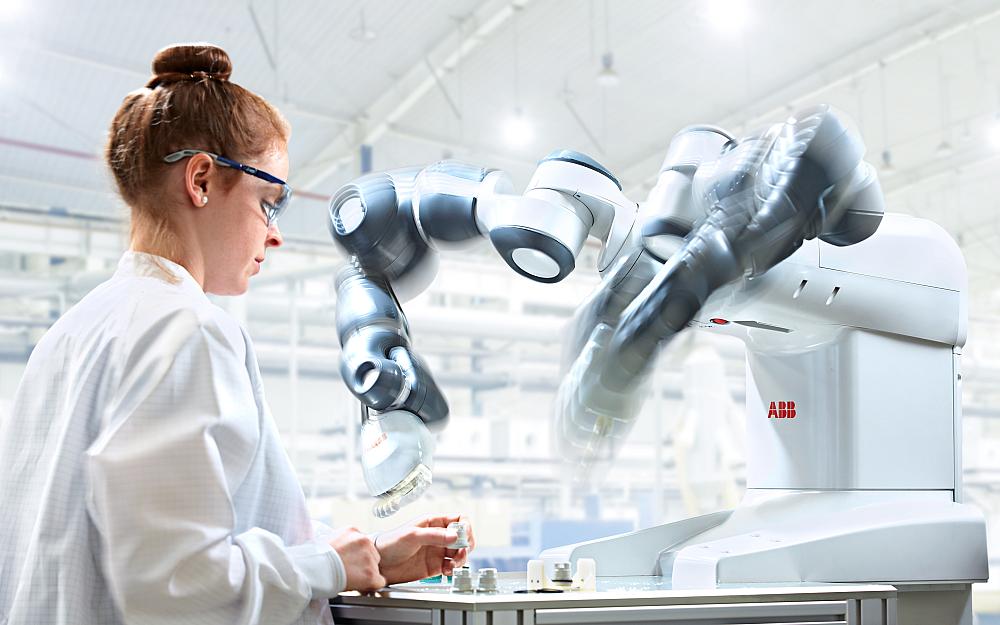Editor-in-Chief
- FMA
- The Fabricator
- FABTECH
- Canadian Metalworking
Categories
- Additive Manufacturing
- Aluminum Welding
- Arc Welding
- Assembly and Joining
- Automation and Robotics
- Bending and Forming
- Consumables
- Cutting and Weld Prep
- Electric Vehicles
- En Español
- Finishing
- Hydroforming
- Laser Cutting
- Laser Welding
- Machining
- Manufacturing Software
- Materials Handling
- Metals/Materials
- Oxyfuel Cutting
- Plasma Cutting
- Power Tools
- Punching and Other Holemaking
- Roll Forming
- Safety
- Sawing
- Shearing
- Shop Management
- Testing and Measuring
- Tube and Pipe Fabrication
- Tube and Pipe Production
- Waterjet Cutting
Industry Directory
Webcasts
Podcasts
FAB 40
Advertise
Subscribe
Account Login
Search
The robots are coming
- By Dan Davis
- April 15, 2015

YuMi, the "collaborative" dual-arm robot from ABB, has the potential to take on various light industrial tasks while working side by side with humans.
Did you meet YuMi earlier this week? It is a “collaborative” dual-arm industrial robot that made its debut at the large industrial automation show, Hannover Messe, in Germany.
What does “collaborative” mean? That what the robot’s creator, ABB, calls automation that can work alongside human workers without anyone being in danger. The robot is aware of the task and surroundings and acts appropriately. The robots that are often found behind large gates, such as the ones that are used to whip around large fabrications in automated bending cells, don’t have this situational awareness; if an operator moves into the work path of one of these material handling robots, that operator is going to fly across the shop floor.
The emergence of these types of robots is not a new development. It’s been underway for a while, and these robots have the potential to transform light manufacturing.
Most metal fabricators don’t give it much thought because they don’t see robots that are capable of keeping up with the complexity and speed that are necessary to produce a variety of metal components or assemblies in a typical day.
During a recent interview, Doug Layman, the founder of a small industrial fabrication shop in North Vernon, Ind., said that he fears for the future of the fabrication industry because people entering the workforce don’t seem to have the same skills and work ethic that his generation did.
“It’s a dying profession. And it’s only going to continue,” the 53-year-old Layman said. “It’s going to be a problem because there are a lot of things that robots just can’t build.”
Those robots can’t build them—yet.
It was only 10 years ago that robotic welding was as common a sight in fab shops as silk bathrobes. That’s not the case anymore. Fabricators are purchasing robotic welding cells that can be moved about the shop floor with a lift truck. It’s automation for the masses.
If you consider the advances being made with vision systems and advanced control software, you have to believe that welding robots may be capable of welding jobs that would have seemed impossible only a decade ago. (Now if those robots could build their own fixtures, then you’d really have something!)
Futurists and manufacturing industry experts know that robots will continue to infiltrate factories and plants around the world. But manufacturing is not alone; it’s a widespread trend, with some suggesting that almost 50 percent of all kinds of jobs will be automated in some shape or form in the future.
The real concern is how humans will react to their new co-workers. Will society see robots as a threat to steal jobs or as tools to take over rudimentary or dangerous jobs?
It’s safe to say that managers and business owners might be less skeptical. As they are quick to point out, robots don’t have girlfriends, don’t need bathroom breaks, don’t call in sick …
subscribe now

The Fabricator is North America's leading magazine for the metal forming and fabricating industry. The magazine delivers the news, technical articles, and case histories that enable fabricators to do their jobs more efficiently. The Fabricator has served the industry since 1970.
start your free subscriptionAbout the Author

Dan Davis
2135 Point Blvd.
Elgin, IL 60123
815-227-8281
Dan Davis is editor-in-chief of The Fabricator, the industry's most widely circulated metal fabricating magazine, and its sister publications, The Tube & Pipe Journal and The Welder. He has been with the publications since April 2002.
- Stay connected from anywhere

Easily access valuable industry resources now with full access to the digital edition of The Fabricator.

Easily access valuable industry resources now with full access to the digital edition of The Welder.

Easily access valuable industry resources now with full access to the digital edition of The Tube and Pipe Journal.
- Podcasting
- Podcast:
- The Fabricator Podcast
- Published:
- 04/16/2024
- Running Time:
- 63:29
In this episode of The Fabricator Podcast, Caleb Chamberlain, co-founder and CEO of OSH Cut, discusses his company’s...
- Trending Articles
Tips for creating sheet metal tubes with perforations

JM Steel triples capacity for solar energy projects at Pennsylvania facility

Are two heads better than one in fiber laser cutting?

Supporting the metal fabricating industry through FMA

Omco Solar opens second Alabama manufacturing facility

- Industry Events
16th Annual Safety Conference
- April 30 - May 1, 2024
- Elgin,
Pipe and Tube Conference
- May 21 - 22, 2024
- Omaha, NE
World-Class Roll Forming Workshop
- June 5 - 6, 2024
- Louisville, KY
Advanced Laser Application Workshop
- June 25 - 27, 2024
- Novi, MI


























